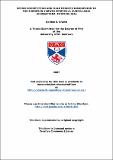Files in this item
Sperm competition and male forceps dimorphism in the European earwig Forficula auricularia (Dermaptera: Forficulina)
Item metadata
| dc.contributor.advisor | Tomkins, Joseph L. | |
| dc.contributor.advisor | Ritchie, Michael G. | |
| dc.contributor.author | Brown, Gordon S. | |
| dc.coverage.spatial | 149 | en |
| dc.date.accessioned | 2008-01-18T12:45:18Z | |
| dc.date.available | 2008-01-18T12:45:18Z | |
| dc.date.issued | 2007-06-22 | |
| dc.identifier | uk.bl.ethos.552005 | |
| dc.identifier.uri | https://hdl.handle.net/10023/409 | |
| dc.description | Some portions of this electronic text have been removed owing to copyright restrictions | en |
| dc.description.abstract | The European earwig exhibits a remarkable male-dimorphism in forceps morphology that is associated with alternative reproductive tactics under the control of a conditional evolutionarily stable strategy. Populations on the small, rocky islands of the Farnes off the Northumberland coast are known to sustain populations with dramatically higher morph ratios than observed on the UK mainland. A survey conducted of island and mainland sites around the UK showed that the dimorphic populations of the Farnes are similar to other islands and that mainland populations generally exhibit low morph ratios. Additionally, a correlation between morph ratio and population density was found lending support to the hypothesis that the ESS thresholds that define the morph ratios have diverged through local adaptation. A set of seven microsatellite markers are presented that were developed from a Farne island population of F. auricularia with one additional, previously published locus. These eight markers exhibit genetic variability within and between populations and as such can potentially be applied at a range of scales, from broad-scale phylogeography to within population parentage studies. A phylogeographic study of the UK populations using these markers suggests a single postglacial colonisation from mainland Europe and give further support to the local adaptation hypothesis of ESS threshold evolution. A study of ejaculate size in F. auricularia showed that the males transfer free sperm at a steady rate and that the morphs do not differ in the number of sperm per ejaculate. Measurements of change in body-mass were found to be ineffective measures of ejaculate size, but that macrolabic males lost more weight during copula than brachylabic males. This may be the result of differential investment in accessory ejaculate components between the morphs, as a result of the differing risk of sperm competition. | en |
| dc.format.extent | 2350319 bytes | |
| dc.format.mimetype | application/pdf | |
| dc.language.iso | en | en |
| dc.publisher | University of St Andrews | |
| dc.rights | Creative Commons Attribution-ShareAlike 3.0 Unported | |
| dc.rights.uri | http://creativecommons.org/licenses/by-sa/3.0/ | |
| dc.subject | Male dimorphism | en |
| dc.subject | Phylogeography | en |
| dc.subject | Microsatellites | en |
| dc.subject | Alternative reproductive tactics | en |
| dc.subject | Conditional strategy | en |
| dc.subject | European earwig | en |
| dc.subject | Forficula auricularia | en |
| dc.subject | Dermaptera | en |
| dc.subject | Sperm competition | en |
| dc.subject.lcc | QL510.3F6B8 | |
| dc.subject.lcsh | European earwig--Reproduction | en |
| dc.subject.lcsh | Sperm competition | en |
| dc.subject.lcsh | Dimorphism (Animals) | en |
| dc.title | Sperm competition and male forceps dimorphism in the European earwig Forficula auricularia (Dermaptera: Forficulina) | en |
| dc.type | Thesis | en |
| dc.contributor.sponsor | Natural Environment Research Council (NERC) | en |
| dc.type.qualificationlevel | Doctoral | en |
| dc.type.qualificationname | PhD Doctor of Philosophy | en |
| dc.publisher.institution | The University of St Andrews | en |
This item appears in the following Collection(s)
Except where otherwise noted within the work, this item's licence for re-use is described as Creative Commons Attribution-ShareAlike 3.0 Unported
Items in the St Andrews Research Repository are protected by copyright, with all rights reserved, unless otherwise indicated.


